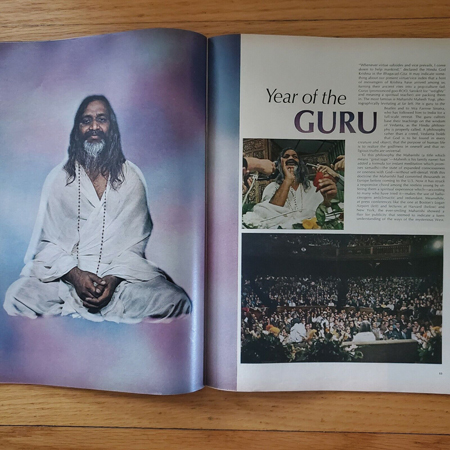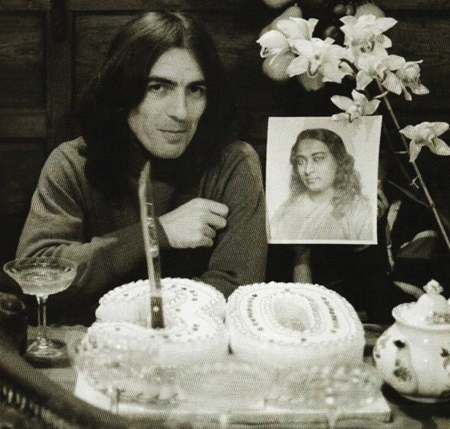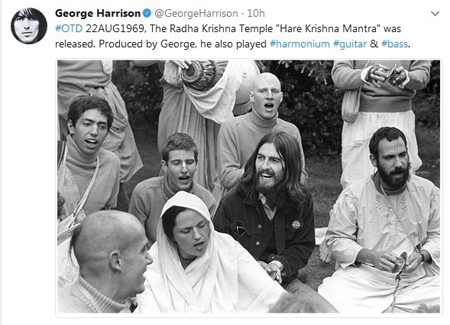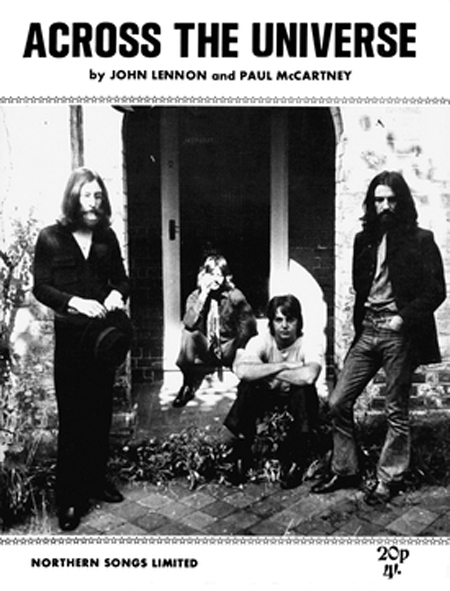Time Capsule: The Rock Stars Who Started a Spiritual Revolution

THE BEATLES ushered in and championed a new movement of meditation and Eastern spirituality in the West.
[Left] The Beatles, with Maharishi Mahesh Yogi in Rishikesh, India in 1968. (Photo: Paul Saltzman)
“In February 1968, the Beatles went to India for an extended stay with their new guru, Maharishi Mahesh Yogi. It may have been the most momentous spiritual retreat since Jesus spent those forty days in the wilderness.”
That’s how I opened my book, American Veda. When it was published in 2010, I braced myself for blowback. Nothing happened. Not a single angry email. No one accused me of demeaning Jesus. No one tried to convince me I was mistaken. Instead, I received dozens of messages from people whose lives had been transformed by the Beatles’ Indian sojourn. It was as though the earth had tilted on its axis, allowing India’s ancient wisdom to flow more easily to the West.
 Much was made about the famous retreat in Rishikesh that started it all. The media, always in pursuit of the Fab Four, descended on this quiet, holy town in the Himalayan foothills. Photographers and reporters, banned from the ashram grounds, tried everything from bribery to perching on trees with the monkeys to get something to publish. As a direct result of the nonstop coverage, formerly esoteric spiritual practices quickly went mainstream.
Much was made about the famous retreat in Rishikesh that started it all. The media, always in pursuit of the Fab Four, descended on this quiet, holy town in the Himalayan foothills. Photographers and reporters, banned from the ashram grounds, tried everything from bribery to perching on trees with the monkeys to get something to publish. As a direct result of the nonstop coverage, formerly esoteric spiritual practices quickly went mainstream.
[Right] So big was the phenomenon of Westerners heading to India, inspired by trendsetters like the Beatles, that Life magazine declared 1968 the “Year of the Guru.”
But let’s back up a few years to better grasp why this happened. The lads from Liverpool had started out as a ragtag band playing in local clubs and, in time, became even bigger than Elvis Presley and Frank Sinatra, who had female fans screaming and weeping at the sight of these two legends. With the Beatles, the fan girls had four rock stars to choose from, each one photogenic and lovable in his own way. As for their music, the beats were danceable, the harmonies infectious, and the lyrics told simple tales of youthful love and heartache.
With their runaway success, and a global following that early in their lives, the Beatles had achieved and done everything society said would make them happy—yet they experienced emptiness and suffering. By the mid- ’60s, the band’s music had become more sophisticated, and their lyrics were deeper and more meaningful. Listen, for instance, to the trenchant observations about life in the modern world in “Nowhere Man” and “Eleanor Rigby” (“All the Lonely People”). Their maturation became an entry point to the spiritual path for the Beatles and many of their contemporaries.
Harrison, the Spiritual Trailblazer
It started with George Harrison. Musically, he was always in the shadow of the songwriting superstars John Lennon and Paul McCartney, and on the cuteness scale, he lagged behind Ringo Starr. But spiritually, he was a trailblazer. When he heard a sitar for the first time during the filming of the 1965 movie Help!, he became intoxicated by its sound. He bought himself a sitar, and that led to the famous opening bars of “Norwegian Wood,” which introduced the instrument to much of the world, eventually giving rise to a genre known as raga rock.
Harrison then enlisted Ravi Shankar, the renowned sitar master, as his mentor. Not only did Shankar become a superstar, bringing Indian music to major venues like Woodstock, but the mentorship brought Harrison to India for an extended visit, during which his spiritual life took a yogic turn that would largely define the rest of his life—and his music.
 Consider the song “Within You Without You.” I think of it as the first rock ‘n’ roll Upanishad, as it teems with nondual insights (“When you’ve seen beyond yourself, then you may find peace of mind is waiting there.”) The album, with Paramahansa Yogananda and his guru lineage on the cover (Harrison’s choice), was released on June 1, 1967, just in time for the Summer of Love. While psychedelic drugs had offered Harrison and his mates a glimpse of the transcendent, the East now beckoned with safer and more dependable methods, including meditation.
Consider the song “Within You Without You.” I think of it as the first rock ‘n’ roll Upanishad, as it teems with nondual insights (“When you’ve seen beyond yourself, then you may find peace of mind is waiting there.”) The album, with Paramahansa Yogananda and his guru lineage on the cover (Harrison’s choice), was released on June 1, 1967, just in time for the Summer of Love. While psychedelic drugs had offered Harrison and his mates a glimpse of the transcendent, the East now beckoned with safer and more dependable methods, including meditation.
[Left] George Harrison is seen here with a photo of Paramahansa Yogananda. (Photo Yogananda Site)
Later that year, on August 24, 1967, Harrison’s wife Pattie took him, McCartney, and Lennon to see Maharishi Mahesh Yogi speak at the London Hilton. The diminutive guru had been circling the globe for about a decade, teaching his Transcendental Meditation (TM). After the talk, the rock stars were ushered backstage.
Within days, all four Beatles plus Mick Jagger, along with their wives and girlfriends, had hopped on a train to Wales to learn the Maharishi’s form of mantra meditation. The practice took hold, and the lads—Harrison and Lennon especially—became public advocates, describing how meditation had changed them for the better.
To some degree, the new awareness became reflected in their music. Listen, for instance, to “The Inner Light,” the lyrics of which Harrison took from the Tao Te Ching. McCartney’s “The Fool on the Hill” was about a guru-like hermit who perceives things the rest of us do not. Lennon’s “Across the Universe” was his paean to the meditative experience with the refrain “Jai Guru Deva” (“Glory to the divine teacher”).
Meditation Has a Moment
Flocks of young people emulated the Beatles, their idols, by learning TM or finding their way to other gurus and Eastern disciplines. The media couldn’t get enough of the story: teens were rejecting drugs in favor of introspective practices that had formerly been of interest only to ascetics, eccentrics, and other “weirdos.” In 1968, Look magazine ran a cover story titled “Non-Drug Turn-On Hits Campus,” and Life magazine declared it the “Year of the Guru.” Then, in early February, a fresh wave of media madness greeted the Beatles’ arrival in India along with Mia Farrow, the Beach Boys’ Mike Love, and folk rocker Donovan.
It would have been easy to dismiss the frenzy as just another pop culture craze. But this was different: four fun-loving youngsters, wealthy beyond imagination, who could go anywhere and do anything, chose to be hunkered down in a vegetarian, un-air-conditioned compound on the River Ganges to spend hours with their eyes closed.
 Thoughtful reporters and social commentators raised questions: why were rock stars—usually the poster children for sex, drugs, and rock ‘n’ roll—attracted to the austerity of an ashram? What was the appeal of this thing called meditation? What could an impoverished India offer celebrities who seemed to have everything a human being could want? Questions like those turned what could have been a brief media burst into a watershed moment in history.
Thoughtful reporters and social commentators raised questions: why were rock stars—usually the poster children for sex, drugs, and rock ‘n’ roll—attracted to the austerity of an ashram? What was the appeal of this thing called meditation? What could an impoverished India offer celebrities who seemed to have everything a human being could want? Questions like those turned what could have been a brief media burst into a watershed moment in history.
[Right] Harrison singing kirtans at a Radha Krishna temple. (Photo X/@ GeorgeHarrison)
Before long, scientists became curious about whether meditation was producing something more than auto-suggestion or a placebo effect. As they began to investigate and, they discovered measurable, quantifiable physiological effects. An explosion of research followed, and within a few years, hundreds of articles appeared in scientific journals with positive implications for healthcare, psychology, and neuroscience. As a result, it wasn’t only acid-head hippies who meditated; it was also their valium-popping parents. And now, of course, physicians and therapists routinely recommend meditation, mindfulness, and yoga postures for wellness purposes.
The truly game-changing result of the Beatles’ India sojourn was an enduring spiritual revolution. It accelerated an East-to-West transmission that had been slowly changing the way we understand religion and engage with the spiritual impulse ever since the days of Ralph Waldo Emerson and the Transcendentalists. The constantly growing cohort known as “spiritual but not religious” would not have been possible without the contemplative methods we imported from the East.
A Legacy in Lyrics
The Beatles broke up about two years after their India experience. During that time, they gave us some spectacular songs, at least two of which, “Let It Be” and “Here Comes the Sun,” have spiritual overtones that have made them standards in the pop music hymnal. As a solo performer, Lennon gave us “Instant Karma”—an unforgiving rant that planted the concept of karma in the public mind—and “Imagine,” perhaps the era’s most beloved spiritual anthem.

But it was Harrison who carried the spiritual torch the highest. For the rest of his life, he took seriously his role as a proponent of Indian wisdom. He produced an album titled “The Radha Krishna Temple,” a selection of Sanskrit chants by Hare Krishna musicians that crashed the pop charts. He followed it up with “Chants of India,” the traditional sacred songs rendered by Ravi Shankar. His own lyrics could easily be edited into a concise synopsis of Hinduism. Check out the devotional “My Sweet Lord” (“I really want to see you . . .”); “Beware of Darkness,” with its warnings about worldly attachments; “Give Me Love,” which evokes the eternal longing of the seeker; “Awaiting on You All,” in which he advises us to chant the names of God; “The Art of Dying,” in which he makes a case for reincarnation; and “Brainwashed,” the title song of his final album, in which he calls God “the lover that we miss,” quotes the Yoga Sutras (“The soul does not love, it is love itself”), and closes with an invocation to the deities Shiva and Parvati.
The Beatles’ place in musical and cultural history will no doubt be commemorated forever. In the long run, however, their role as unlikely spiritual pioneers may have an even bigger impact.
[Left] John Lennon’s album, “Across the Universe,” was his paean to the meditative experience, with the refrain “Jai Guru Deva” (“Glory to the divine teacher”).
Philip Goldberg is the author of numerous books, including the award-winning American Veda, The Life of Yogananda, and his latest, Spiritual Practice for Crazy Times. He co-hosts the Spirit Matters podcast, blogs at Spirituality & Health, and leads American Veda Tours to India. He can be contacted through his website, www.philipgoldberg.com. To comment on this article, please write to letters@khabar.com. A version of this article appeared in Spirituality & Health.
Enjoyed reading Khabar magazine? Subscribe to Khabar and get a full digital copy of this Indian-American community magazine.
blog comments powered by Disqus










